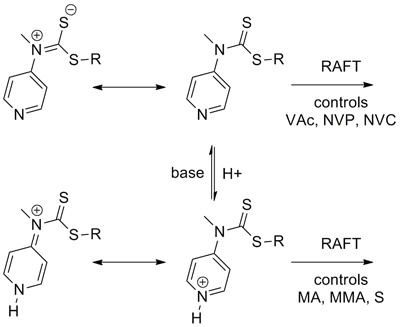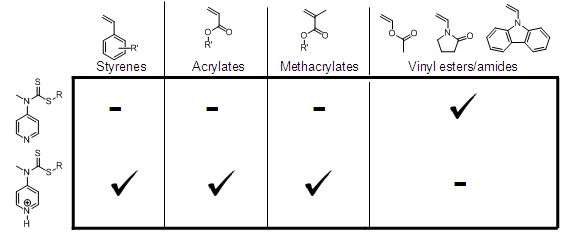Universal (Switchable) RAFT Agents for Well-Defined Block Copolymers
Jeremy Bartels, Sebastian Grajales
Introduction to Switchable RAFT Agents
Reversible Addition/Fragmentation chain Transfer (RAFT) polymerization (RAFT Polymerization Introduction) is a versatile controlled radical polymerization method.1-3 In fact, most vinyl monomers that are polymerizable by radical polymerization can be polymerized via RAFT.4 However, the appropriate RAFT agent must be selected for a given monomer type in order to obtain living polymerization characteristics due to differences in reactivity. In general, RAFT agents such as dithioesters2 and trithiocarbonates5 work well with controlling the polymerization of ”more-activated“ monomers (MAMs), such as styrene (Sty), methyl acrylate (MA), and methyl methacrylate (MMA), meanwhile dithiocarbamates6,7 and xanthates8 must be used to control the polymerization of ”less activated“ monomers (LAMs), such as vinyl acetate (VAc), N-vinylpyrrolidone (NVP), and N-vinylcarbazole (NVC). Improper pairing (e.g. dithiocarbamate RAFT agent with MMA monomer) will inhibit or significantly limit the polymerization.5
Differences in the reactivity of vinyl monomers have historically limited the ability to form block copolymers comprised of MAMs and LAMs (poly(MAM)-block-poly(LAM)) with a narrow molecular weight distribution. In an effort to overcome this limitation, CSIRO scientists have recently reported switchable (universal) RAFT agents.1 These specialty RAFT agents are dithiocarbamates that are able to control the polymerization of MAMs when the pyridyl nitrogen is protonated and then readily control the polymerization of LAMs when deprotonated (Scheme 1).

Scheme 1.Differences in the canonical forms of protonated and deprotonated N-methyl, N-(4-pyridyl)dithiocarbamates. When protonated the agents can control polymerization of MAMs (such as Sty, MA, MMA) and then when deprotonated, the RAFT agents can effectively control polymerization of LAMs (such as VAc, NVP and NVC).1, 9
Practical Considerations
This novel approach can be performed in situ via direct polymerization in solution and is rapid and reversible. The best control over the polymerization is achieved by protonation of the 4-pyridyl group with a stoichiometric amount of a strong organic acid (e.g. p-toluenesulfonic acid, trifluoromethanesulfonic acid, etc).10 Alternatively, coordination of the 4-pyridyl group with Lewis acids such as Al(OTf)3 will also work.10 Deprotonation can be performed in situ using organic bases such as N,N-dimethylaminopyridine (DMAP),1 or can be achieved by passing a polymer solution through a crushed sodium carbonate bed.
In order to prepare well-defined block copolymers using switchable RAFT agents, the MAM block segment should be polymerized first with a protonated RAFT agent, followed by deprotonation and subsequent polymerization of the LAM block(s).1,9,10 This is primarily due to the fact that terminal LAM groups are poor radical leaving groups, leading to poor blocking efficiency in the presence of MAMs, whereas poly(MAM)s tend to have high chain transfer constants relative to LAMs. In certain cases, it is strongly recommended (particularly when initiating the polymerization of a vinyl acetate block from a polystyrene macro chain transfer agent) that all traces of residual MAM are removed (either by precipitation or vacuum distillation). Trace MAM in the solution could lead to inhibition of future polymerization events. Additionally, in some cases an intermediate monomer may need to be added to bridge the reactivity between MAM and LAM units. In the case of styrene and vinyl acetate, a small amount of methyl acrylate (~5%) can be added, after all Sty monomer is consumed or removed, to a solution of the polystyrene macroCTA and vinyl acetate. The polystyrene macroCTA will incorporate the methyl acrylate and the vinyl acetate in a gradient fashion before leading to a true vinyl acetate block once all methyl acrylate is consumed.
RAFT Agent to Monomer Compatibility Table
The compatibility of switchable RAFT agents, available in our catalog, with common monomers used in polymerizations is shown in Table 1. The checks and dashes represent the compatibility and incompatibility, respectively, between monomer classes and a protonated and non-protonated form of switchable RAFT agent. For example, 2-Cyanopropan-2-yl N-methyl-N-(pyridin-4-yl)carbamodithioate, Prod No. 736236, is very useful in polymerizing styrenes, methacrylates and methacrylamides when protonated but shows poor activity in controlling vinyl esters or vinyl amides.

Table 1.The non-protonated and protonated RAFT agents available in our catalog, with their suitability for selected monomer types (check = compatible; dash = incompatible).
References
如要继续阅读,请登录或创建帐户。
暂无帐户?